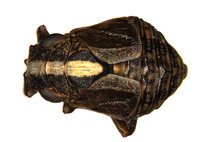Abstract
The extinct members of the Psallopinae are important for classifying and understanding the relationships among the closely related mirid groups Isometopinae, Psallopinae (sensu Schuh, 1976) and Cylapinae. These subfamilies are considered to be the most primitive sister groups among mirids and their taxonomical composition, geographical distribution and life history are still poorly known. Extant Psallopinae appear to live on tree trunks and bark. For instance, the species Psallops myiocephalus Yas. from Japan is only known from an oak Quercus acutissima (Yasunaga, 1999). The 14 extant species of this genus have been described from Old World tropics, subtropics and warm temperate regions: Micronesia (Guam, Marian and Caroline Islands), Saudi Arabia, Nigeria, Ghana, Congo, Singapore, South Africa, Japan, China, Taiwan and Thailand (Usinger, 1946; Carvalho, 1956; Linnavuori & Alamy, 1986; Schuh, 1995; Yasunaga, 1999; Lin, 2004, 2006; Yasunaga & Yamada, 2010; Herczek & Popov, 2014).

